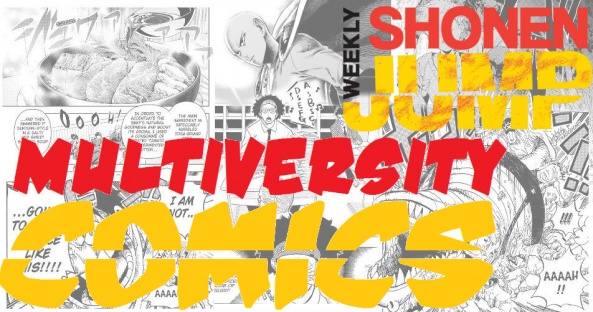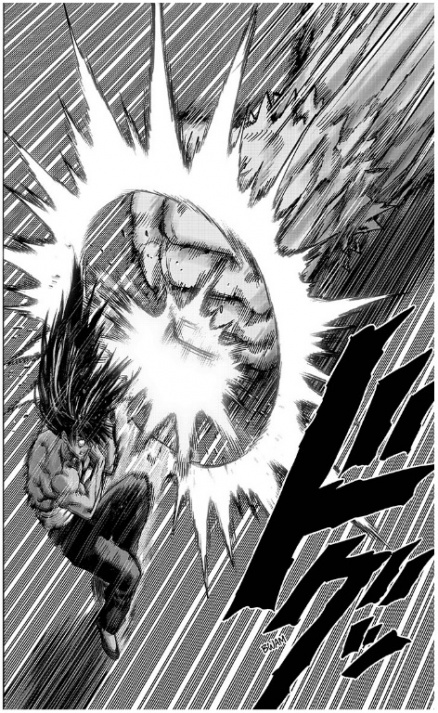
Welcome to This Week in Shonen Jump, in which a rotating duo of Multiversity staffers take a look at two stories contained in each installment of Viz Media’s Weekly Shonen Jump. For the uninitiated, Weekly Shonen Jump is an anthology that delivers more than 200 pages of manga of all varieties. We hope that you’ll join us in exploring the world of Weekly Shonen Jump each week. If you are unfamiliar, you can read sample chapters and subscribe at Viz.com.

This week, Rowan and Matt check in with “Black Clover” and “One Punch Man” and If you have any thoughts on these titles, or “Food Wars,” “One Piece,” “Robot X Laserbeam,” “Memories with Oda-San,” “Dr. Stone,” “My Hero Academia,” “The Promised Neverland,” “We Never Learn,” or “Hunter X Hunter,” let us know in the comments!

Black Clover Chapter 117
Written and Illustrated by Yuki Tabata
Reviewed by Rowan Grover
Straight off the bat, I love how two faced “Black Clover” can be with its characters. The flamboyant Kirsch has a habit of switching to morbidly dark as soon as someone he doesn’t deem worthy talks around him, and it has a great comedic effect with character developing undertones. Similarly, Leopold works as a good mentor type for Asta, feeling like an older version of the latter’s character but with more self-control and maturity about him. Yuki Tabata has a good handle on introducing new characters like this, and making them feel important – even if they’re only being used for cannon fodder. However, bring a character like Finral into the fray, and there’s some sinister currents that float through the story. It serves well to develop intrigue and remind the reader that there’s always something sinister going on behind the seemingly innocent displays.
There is a lot crammed in here, for good and for worse at times. As I said, Tabata introduces hiss characters meaningfully and deftly – giving them all introduction-type plaques at the bottom of each panel they first appear in. It’s fun to see how well-crafted they are from the get go, but makes it hard to keep track of who’s meaningful to the plot and who’s not. It’s not a bad thing to have flat characters that make the protagonists look better, but Tabata has made everyone distractingly interesting. Following from that, we don’t get a lot of main plot development, as every panel Asta appears in here is simply him fanboying for others, and a lot of the scenes show battles in the tournament. I will say this in the manga’s favour – Tabata has me caught hook line and sinker on the Roulacase brothers’ feud. There’s just enough told to satisfy me initially, and enough left out for me to speculate about what could be happening which, as a reader, is a lot of fun.
Tabata gets to show off with some great action art in this chapter with dynamic magic battles. I feel the best way to put it is – everything feels really sharp and dangerous. The first battle with Leopold (a character who himself has very sharp looking hair) runs at a breakneck speed, with crystals ready to be broken and glass shards shooting up from empty air. It’s all very surreal, but catches and immerses you with its uncompromising approach to combat. The second battle scene with the younger Roulacase brother is just as fast-paced but with a sense of dread Tabata conveys through the character’s ever present grin. It’s a very different type of frantic to the first scene, but just as effective at conveying a mood – in this case, the sense of terror at the younger Roulacase’s sheer power.
The environment and architecture is interesting for the time that it appears. Tabata has a great fusion of intricate eastern and medieval western influences on the set design, especially with the setting panels that kick off a match. The landscape is a battlefield mishmash of environments, with dense forestation, rocky plateaus and ocean all featuring in one scene. However, beyond these setting establishing scenes, we never see much of the environment during the battles, making them feel a little sparse and bland at times. The fast-paced nature of the fights helps this, never really making them boring, but I feel that it would be more interesting with some context in the background.
Continued below“Black Clover” remains to be one of the most solid Shonen ongoings at the moment, but it falls into the same old traps that stop it from achieving greatness. It’s understandable that not every chapter can be as significant due to the long form nature of the story, so it doesn’t hurt the flow greatly, but “Black Clover” could afford to be more original in its execution.
Final Verdict: 6.6 – A fun entry in the current ‘Magic Knights’ saga that unfortunately doesn’t go beyond serviceable.

OnePunch-Man Chapter 71
Written by One
Illustrated by Yusuke Murata
Reviewed by Matt Lune
A chapter of “OnePunch-Man” without the titular character, but there’s hardly time to miss him because, once again, this is a frenetic chapter that doesn’t slow down for a second.
No, Saitama isn’t anywhere to be seen this time around, so Suiryu – his main opponent during the fighting tournament – takes central focus, as he attempts to stand his ground against the invading monster Gouketsu and his henchmen The Three Crows. It’s a brutal chapter, and that’s saying something for a series heavy on the violence, but we’re at the phase in all “OnePunch-Man” arcs where the Big Bad is being set up. As such, Gouketsu has to be established as a creature truly fearsome and unbeatable, and in this case that manifests in him handily absorbing all of Suiryu’s attacks and even toying with the fighting champion. Suiryu’s been played for many chapters now as the Ultimate Human, someone physically unmatched and literally unbeatable in the ring for close to a decade. Obviously, Saitama dispatched him easily with – you guessed it – one punch, but to see him so casually and violently overwhelmed by a monster has the desired effect.
The concept of monsters being so all-powerful is coming more and more to the forefront in this series, and it’s highlighted especially well in this chapter. Here, fellow fighter Bakuzan has been watching the fight from the sidelines. His justification for not helping Suiryu in his time of need is simple: Monsters are more powerful in every way. The most powerful human is no match for even the weakest monster, therefore the only way to beat them is to become them. For a society that seems geared around strength as a fundamental hierarchical structure to their culture, it’s interesting to start seeing this revelation in ways beyond “how will we defeat the monsters” and instead “how do we adapt to this new threat?”
Yusuke Murata’s artwork is insane. There’s a reason “OnePunch-Man” is viewed by many as one of the best superhero comics being published today. The sense of scale has always been Murata’s strength; establishing the sheer size of these invading monsters makes the actions of the heroes even more impressive. Here, Gouketsu is a behemoth that looms over every panel he’s in, and Suiryu – a man ridiculously muscular and impressive in his own right – looks miniscule in comparison. The other strength of Murata’s art is the pacing. Most western superhero comics choose snapshots of a battle, or a double page montage approach. Here though, every action scene is choreographed to a frantic degree; every punch is set up and lands perfectly, every movement is portrayed so dynamically, with thousands of speed lines that make every panel feel like a blisteringly fast-paced ballet. It’s sometimes overwhelming, but it’s always breathtaking. Literally, as in it never slows enough to even let you breathe.
By this point in the series we know what’s going on. This entire chapter is a setup to make Gouketsu seem as powerful as possible, to portray the monster as the greatest threat this world has ever seen, so that when Saitama dispatches him with a single punch it’s all that more impressive and rewarding. You’d think that conceit would get boring after 71 chapters and over 11 volumes of the same joke, but it’s here, in chapters like this that set all of that up, that makes “OnePunch-Man” the exception to the rule. This series tackles the build up so well that any repetition is forgiven. By taking this stage of the story so seriously – there are jokes, but the weight of the battle and the stakes at risk are all real – you feel that this threat really is the biggest they’ve ever faced, and you can’t wait for Saitama to return and do his thing.
Final Verdict: 8.5 – We know that Saitama will punch the Big-Bad eventually, but chapters like this set that inevitable moment up really well.






